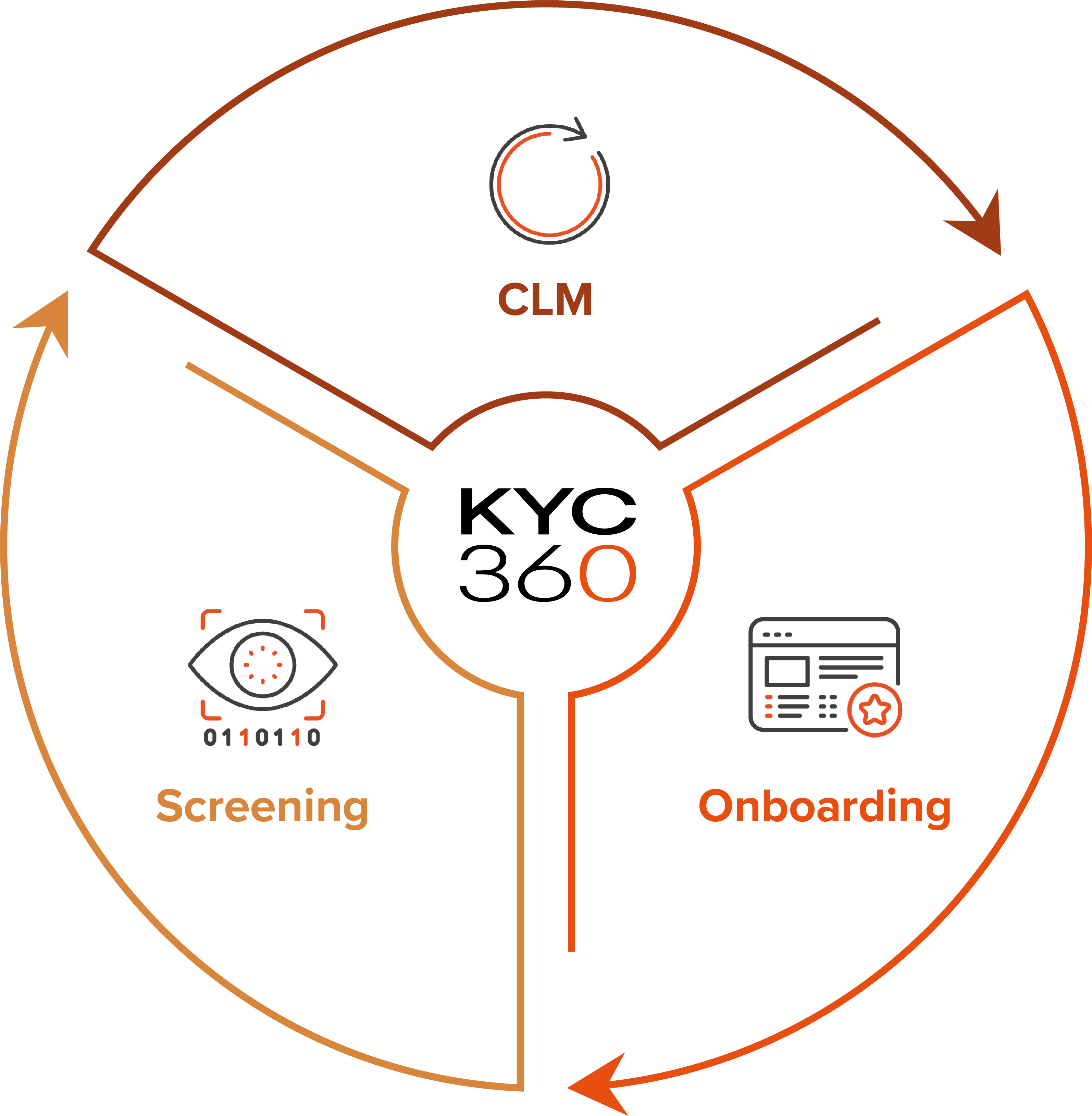Addressing Data Management Challenges in the KYC Process with Client Lifecycle Management Solutions
Client Lifecycle Management (CLM) platforms are emerging as a critical solution. By unifying customer data and enabling continuous monitoring throughout the entire client lifecycle, CLM enables organisations to move from reactive to proactive risk management. It shifts the focus from isolated compliance tasks to a holistic, integrated model that supports strategic decision-making, improves operational efficiency, and strengthens regulatory resilience.
This article explores the growing complexity of KYC requirements, the persistent challenges of managing data across the client lifecycle, and how modern CLM platforms can transform compliance from a burden into a competitive advantage that elevates customer experience.
Navigating the complexity of the regulatory environment
Financial institutions must navigate a patchwork of evolving regulatory frameworks across jurisdictions, each with its own expectations around data handling, client verification, and ongoing monitoring. Regulators demand demonstrable, auditable control over client data and risk exposure and, enforcement actions for non-compliance are rising.
There are four key drivers shaping this increasingly complex regulatory environment.
- Evolving global regulatory frameworks
Regulations and rules and their interpretations can vary and change quickly across jurisdictions and, therefore firms must manage cross-border obligations with agility. They also contend with differing risk appetites across business units, which further increases complexity. - Increasing data privacy requirements
Regulations like GDPR and equivalents globally are pushing firms to rethink how they collect, store, and share customer data. As a result, KYC processes must ensure data security and transparency. - Digital transformation pressures
Organisations are under pressure to digitise manual processes. However, integrating new technologies with legacy systems can be complex and resource-intensive. Additionally, firms must ensure that the appropriate level of human oversight remains in these processes, or the risk of blind spots and compliance gaps may increase. - Intersection of regulation and technology
Regulatory expectations continue to rise. It’s no longer enough to think of compliance as a tick-box exercise. Firms must demonstrate they have dynamic workflows and system-based triggers to detect and respond to risk. In the fast-evolving regulatory landscape, a reactive approach is unsustainable, and organisations require flexible integrated systems that adapt to regulatory change without compromising on operational performance.
Data management challenges
Despite significant investment in new technologies, many financial institutions face critical data management challenges across the client lifecycle. These challenges are rooted in the structure of legacy processes, organisational silos, and inconsistent ownership of data across departments. Without addressing these foundations, advanced technologies will fail to deliver meaningful outcomes or reduce risk.
Structural barriers to effective data management
Many firms operate with decentralised compliance ownership. Different departments, systems, and teams tend to hold partial responsibility for data quality and reporting. This fragmented approach makes it difficult to maintain a consistent, end-to-end view of client risk. Hierarchies, competing internal priorities, and outdated workflows further inhibit the kind of cross-functional collaboration that robust data governance requires.
Practical challenges of information integration
Even when the will to unify systems exists, technical and operational obstacles often stand in the way. Integrating disparate systems, particularly those built on legacy infrastructure, can be slow and expensive. Data mapping efforts often reveal fundamental inconsistencies in how customer information is stored, updated, and interpreted across platforms.
Key data issues include:
- Data accuracy and consistency
Duplicate records, inconsistent naming conventions, and outdated entries are common. These errors not only undermine risk assessments but also increase the necessity of remediation projects which can be costly and resource-intensive. - System integration
Many compliance teams rely on multiple unconnected systems. The lack of interoperability results in time-consuming workarounds and patchy oversight. - Real-time monitoring limitations
Without live data flows and up-to-date risk profiles, most firms rely on manual periodic reviews that capture only a snapshot of client activity. This leaves blind spots in risk exposure and weakens responsiveness. - Scalability constraints
As regulatory demands increase, compliance workloads grow. Legacy systems can struggle to scale and adapt to new demands of data management. - Organisational data silos
Departments often guard their data domains, preventing unified governance. These silos make it difficult to build a single source of truth for compliance decisions.
Addressing these challenges demands a strategic rethink of how data flows, who owns it, and how it supports regulatory outcomes.

Client Lifecycle Management: A Strategic Solution
Client Lifecycle Management (CLM) solutions represent a shift in how compliance is operationalised across the entire client journey. Rather than treating onboarding and periodic reviews as isolated events, CLM creates a continuous, connected process where customer data, risk insights, and follow-up actions are all managed within a unified framework.This solves the key business problem of fragmented data ownership. When client information is collected once, then reused consistently across systems, institutions can eliminate duplication, reduce manual handling, and accelerate decision-making. More importantly, they gain the ability to build a comprehensive, real-time view of risk that is aligned with regulatory expectations.
Modern CLM platforms support this through key capabilities, including:
- End-to-end workflow orchestration, from onboarding through to offboarding
- Centralised data repositories with configurable access controls
- Risk-scoring logic and automated alerts tied to defined triggers
- Audit trails and dashboards for efficient internal and regulatory reporting
By embedding compliance into everyday processes, organisations reduce their dependence on manual workarounds and empower their teams to focus on higher-value activities. Crucially, CLM supports adaptability. As regulatory expectations evolve, rules and workflows can be reconfigured without rebuilding entire systems. This allows institutions to stay ahead of compliance demands.
Discover how KYC360’s Customer Lifecycle Managament (CLM) solution transforms compliance into a strategic advantage.
Key benefits of CLM solutions
- Unified data integration
Siloed systems are a core obstacle to robust compliance. CLM solutions centralise client data across teams and functions, breaking down barriers that delay reviews and obscure risk. By enforcing data standards and shared ownership, organisations gain a single view of the customer that supports faster, more consistent decision-making. This is achieved through both internal data consolidation and integrating external sources, which automates PEP and sanctions screening and keeps client risk profiles up to date. - Enhanced data accuracy and quality
Compliance gaps and failures often begin with poor data. CLM improves accuracy through proactive validation, standardised inputs, and real-time updates. Rather than cleaning data reactively with time-consuming projects, organisations can rely on consistent, structured records from day one. This reduces remediation effort, enables sharper risk insights, and strengthens trust in the data driving key decisions.
- Workflow automation in KYC processes
Manual tasks slow compliance and introduce risk. CLM replaces fragmented, error-prone steps with automated workflows that handle onboarding, reviews, screening and escalation paths efficiently. Automation accelerates processes without removing oversight. - Adaptive regulatory compliance
Regulatory change is constant. CLM platforms support dynamic compliance by enabling teams to update workflows and rules centrally as regulations evolve. This flexibility helps firms avoid last-minute compliance challenges and maintain alignment across jurisdictions, reducing both cost and risk. - Comprehensive data security
Security is integral to compliance. CLM solutions can help to protect sensitive client data throughout the lifecycle. This safeguards against breaches, builds regulator trust, and reinforces client confidence in how their data is handled.
Conclusion
The pressure to effectively manage compliance risk is growing. However, organisations can reframe compliance as a strategic advantage. Traditional KYC models, built on disconnected systems and manual reviews, no longer meet the demands of today’s regulatory and operational landscape. The real challenge is not just staying compliant, but doing so in a way that’s scalable, adaptable, and informed by data.
Client Lifecycle Management solutions offer a way to unify fragmented processes, enhance data quality, and build resilience into every stage of the client journey. By embedding compliance into a centralised, automated framework, firms can reduce risk, improve efficiency, and respond confidently to regulatory change.
